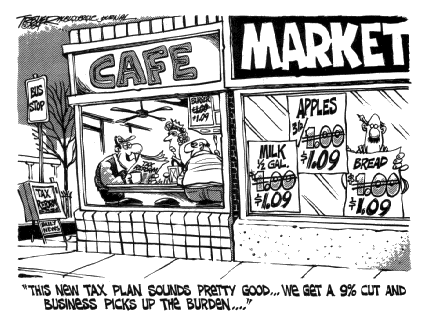

 June 12, 2008
June 12, 2008 I'm often asked about what I think a commercial property may be worth. If it's a commercial property with existing positive cash flow, there is a quick way to provide a reasonable estimate. It involves determining an appropriate "cap rate" for the property. Regards, Today's Smile
This gal wrote: One day my housework-challenged husband decided to wash his sweatshirt. Seconds after he stepped into the laundry room, he shouted to me, "What setting do I use on the washing machine?" "It depends," I replied. "What does it say on your shirt?" He yelled back, "University of Oklahoma."
What's your property worth?The capitalization rate (or "cap rate") is a measure of the ratio between the cash flow produced by an asset (usually real estate) and its capital cost (the original price paid to buy the asset) or alternatively its current market value. The rate is calculated in a simple fashion as follows: • annual cash flow / cost (or value) = Cap Rate For example, if a building is purchased for $1,000,000 sale price and it produces $100,000 in positive net cash flow (the amount left over after fixed costs and variable costs are subtracted from gross lease income) during one year, then: • $100,000 / $1,000,000 = 0.10 = 10% The asset's capitalization rate is ten percent. Capitalization rates are an indirect measure of how fast an investment will pay for itself in net cash flows; each year, the percentage amount of the cap rate will be repaid. In the example above, the purchased building will be fully capitalized (pay for itself) after ten years (100% divided by 10%). If the capitalization rate were 5%, the payback period would be twenty years. Note that in real estate appraisal in the U.S., a stylized measure of cash flow is often used, called net operating income. It is essentially the same as net cash flow, except that debt service and income taxes are not included while a reserve for replacements is included. Where sufficiently detailed information is not available, the capitalization rate will be derived or estimated from income to determine cost, value or required annual income. Use for valuation In real estate investment, real property is often valued according to projected capitalization rates used as investment criteria. This is done by algebraic manipulation of the formula above: • Cost of the Asset = Cash flow / Capitalization Rate For example, in valuing the projected sale price of an apartment building that produces an annual net cash flow of $10,000, if we set a projected capitalization rate at 7%, then the asset value (or price we would pay to own it) is $142,857. This is often referred to as direct capitalization, and is commonly used for valuing income generating property in a real estate appraisal. One advantage of capitalization rate valuation is that it is separate from a "market-comparables" approach to an appraisal (which only compares what other similar properties have sold for based on a comparison of physical characteristics). Given the inefficiency of real estate markets, multiple approaches are generally preferred when valuing a real estate asset. Capitalization rates for similar properties, and particularly for "pure" income properties, are usually compared to ensure that estimated revenue is being properly valued. Cash flow defined The capitalization rate is calculated using a measure of cash flow called net operating income (NOI), not net income. Generally, NOI is defined as income (earnings) before depreciation and interest expenses: • Cash flow = Net income + depreciation + interest expense + profit tax - reserves for repairs = Gross income - non-interest expenses Interest expenses are excluded so that the valuation of the property does not depend on the amount of debt used to purchase the property; in financial terms, the cap rate is an unlevered valuation measure. Similarly, profit taxes (or other similar taxes) are usually excluded, as they will depend on the interest and depreciation expenses charged; most other taxes, and specifically property taxes, are treated as part of non-interest expenses. Until next week, I appreciate having all of you as friends and clients and hope this letter finds everything well with you and your families. P.S. Don't forget to share this email with your friends and colleagues. Our business depends on referrals from contacts like you, and I truly appreciate your help. Best Regards, Ken Kenneth Kaplan ken@K2Cfinance.com www.k2cfinance.com K2 Commercial Finance 13 Goldeneye Court New Britain, PA 18901 Office 215-230-1885
K2 Commercial Finance offers a variety of products and programs designed to meet your commercial mortgage needs. We have created a niche serving commercial borrowers with financing needs of between $150,000 and $5 million. High loan-to-values, quick closes and amortizations of up to 30 years are just a few of the features enjoyed by clients. |